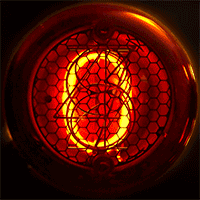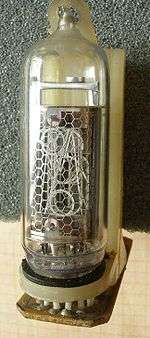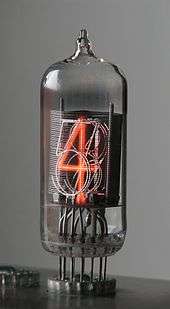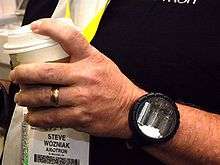Nixie tube

A Nixie tube (English /ˈnɪk.siː/ NIK-see), or cold cathode display,[1] is an electronic device for displaying numerals or other information using glow discharge.

The glass tube contains a wire-mesh anode and multiple cathodes, shaped like numerals or other symbols. Applying power to one cathode surrounds it with an orange glow discharge. The tube is filled with a gas at low pressure, usually mostly neon and often a little mercury or argon, in a Penning mixture.[2][3]
Although it resembles a vacuum tube in appearance, its operation does not depend on thermionic emission of electrons from a heated cathode. It is therefore called a cold-cathode tube (a form of gas-filled tube), or a variant of neon lamp. Such tubes rarely exceed 40 °C (104 °F) even under the most severe of operating conditions in a room at ambient temperature.[4] Vacuum fluorescent displays from the same era use completely different technology—they have a heated cathode together with a control grid and shaped phosphor anodes; Nixies have no heater or control grid, typically a single anode, and shaped bare metal cathodes.
History

The early Nixie displays were made by a small vacuum tube manufacturer called Haydu Brothers Laboratories, and introduced in 1955[5] by Burroughs Corporation, who purchased Haydu. The name Nixie was derived by Burroughs from "NIX I", an abbreviation of "Numeric Indicator eXperimental No. 1",[6] although this may have been a backronym designed to evoke a mythical creature. Hundreds of variations of this design were manufactured by many firms, from the 1950s until the 1990s. The Burroughs Corporation introduced "Nixie" and owned the name Nixie as a trademark. Nixie-like displays made by other firms had trademarked names including Digitron, Inditron and Numicator. A proper generic term is cold cathode neon readout tube, though the phrase Nixie tube quickly entered the vernacular as a generic name.
Burroughs even had another Haydu tube that could operate as a digital counter and directly drive a Nixie tube for display. This was called a "Trochotron", in later form known as the "Beam-X Switch" counter tube; another name was "magnetron beam-switching tube", referring to their similarity to a cavity magnetron. Trochotrons were used in the UNIVAC 1101 computer, as well as in clocks and frequency counters.
The first trochotrons were surrounded by a hollow cylindrical magnet, with poles at the ends. The field inside the magnet had essentially-parallel lines of force, parallel to the axis of the tube. It was a thermionic vacuum tube; inside were a central cathode, ten anodes, and ten "spade" electrodes. The magnetic field and voltages applied to the electrodes made the electrons form a thick sheet (as in a cavity magnetron) that went to only one anode. Applying a pulse with specified width and voltages to the spades made the sheet advance to the next anode, where it stayed until the next advance pulse. Count direction was not reversible. A later form of trochotron called a Beam-X Switch replaced the large, heavy external cylindrical magnet with ten small internal metal-alloy rod magnets which also served as electrodes.

Glow-transfer counting tubes, similar in essential function to the trochotrons, had a glow discharge on one of a number of main cathodes, visible through the top of the glass envelope. Most used a neon-based gas mixture and counted in base-10, but faster types were based on argon, hydrogen, or other gases, and for timekeeping and similar applications a few base-12 types were available. Sets of "guide" cathodes (usually two sets, but some types had one or three) between the indicating cathodes moved the glow in steps to the next main cathode. Types with two or three sets of guide cathodes could count in either direction. A well-known trade name for glow-transfer counter tubes in the United Kingdom was Dekatron. Types with connections to each individual indicating cathode, which enabled presetting the tube's state to any value (in contrast to simpler types which could only be directly reset to zero or a small subset of their total number of states), were trade named Selectron tubes.
Devices that functioned in the same way as Nixie tubes were patented in the 1930s, and the first mass-produced display tubes were introduced in 1954 by National Union Co. under the brand name Inditron. However, their construction was cruder, their average lifetime was shorter, and they failed to find many applications due to their complex periphery.
Design
The most common form of Nixie tube has ten cathodes in the shapes of the numerals 0 to 9 (and occasionally a decimal point or two), but there are also types that show various letters, signs and symbols. Because the numbers and other characters are arranged one behind another, each character appears at a different depth, giving Nixie based displays a distinct appearance. A related device is the pixie tube, which uses a stencil mask with numeral-shaped holes instead of shaped cathodes. Some Russian Nixies, e.g. the IN-14, used an upside-down digit 2 as the digit 5, presumably to save manufacturing costs as there is no obvious technical or aesthetic reason.
Each cathode can be made to glow in the characteristic neon red-orange color by applying about 170 volts DC at a few milliamperes between a cathode and the anode. The current limiting is normally implemented as an anode resistor of a few tens of thousands of ohms. Nixies exhibit negative resistance and will maintain their glow at typically 20 V to 30 V below the strike voltage. Some color variation can be observed between types, caused by differences in the gas mixtures used. Longer-life tubes that were manufactured later in the Nixie timeline have mercury added to reduce sputtering[4] resulting in a blue or purple tinge to the emitted light. In some cases, these colors are filtered out by a red or orange filter coating on the glass.
One advantage of the Nixie tube is that its cathodes are typographically designed, shaped for legibility. In most types, they are not placed in numerical sequence from back to front, but arranged so that cathodes in front obscure the lit cathode minimally. The digit sequence is rarely given; one arrangement is 6 7 5 8 4 3 9 2 0 1 from front (6) to back (1).[7]
Applications and lifetime

Nixies were used as numeric displays in early digital voltmeters, multimeters, frequency counters and many other types of technical equipment. They also appeared in costly digital time displays used in research and military establishments, and in many early electronic desktop calculators, including the first: the Sumlock-Comptometer ANITA Mk VII of 1961 and even the first electronic telephone switchboards. Later alphanumeric versions in fourteen segment display format found use in airport arrival/departure signs and stock ticker displays. Some elevators used Nixies to display floor numbers.
Average longevity of Nixie tubes varied from about 5,000 hours for the earliest types, to as high as 200,000 hours or more for some of the last types to be introduced. There is no formal definition as to what constitutes "end of life" for Nixies, mechanical failure excepted. Some sources[2] suggest that incomplete glow coverage of a glyph ("cathode poisoning") or appearance of glow elsewhere in the tube would not be acceptable.
Nixie tubes are susceptible to multiple failure modes, including
- simple breakage,
- cracks and hermetic seal leaks allowing the atmosphere to enter,
- cathode poisoning preventing part or all of one or more characters from illuminating,
- increased striking voltage causing flicker or failure to light,
- sputtering of electrode metal onto the glass envelope blocking the cathodes from view,
- internal open or short circuits which may be due to physical abuse or sputtering.
Driving Nixies outside of their specified electrical parameters will accelerate their demise, especially excess current, which increases sputtering of the electrodes. A few extreme examples of sputtering have even resulted in complete disintegration of Nixie-tube cathodes.
As testament to their longevity, and that of the equipment which used them, in 2006 several suppliers still provide common Nixie-tube types as service-replacement parts, new in original packaging. Equipment with Nixie-tube displays in excellent working condition is still plentiful, though much of it has been in frequent use for 30–40 years or more. Such items can easily be found as surplus and obtained at very little expense. In the former Soviet Union, Nixies were still being manufactured in volume in the 1980s, so Russian and Eastern European Nixies are still available.
Alternatives and successors
Other numeric-display technologies concurrently in use included backlit columnar transparencies ("thermometer displays"), light pipes, rear-projection and edge-lit lightguide displays (all using individual incandescent or neon light bulbs for illumination), Numitron incandescent filament readouts,[8] Panaplex seven-segment displays, and vacuum fluorescent display tubes. Before Nixie tubes became prominent, most numeric displays were electromechanical, using stepping mechanisms to display digits either directly by use of cylinders bearing printed numerals attached to their rotors, or indirectly by wiring the outputs of stepping switches to indicator bulbs. Later, a few vintage clocks even used a form of stepping switch to drive Nixie tubes.
Nixie tubes were superseded in the 1970s by light-emitting diodes (LEDs) and vacuum fluorescent displays (VFDs), often in the form of seven-segment displays. The VFD uses a hot filament to emit electrons, a control grid and phosphor-coated anodes (similar to a cathode ray tube) shaped to represent segments of a digit, pixels of a graphical display, or complete letters, symbols, or words. Whereas Nixies typically require 180 volts to illuminate, VFDs only require relatively low voltages to operate, making them easier and cheaper to use. VFDs have a simple internal structure, resulting in a bright, sharp, and unobstructed image. Unlike Nixies, the glass envelope of a VFD is evacuated rather than being filled with a specific mixture of gases at low pressure.
Specialized high-voltage driver chips such as the 7441/74141 were available to drive Nixies. LEDs are better suited to the low voltages that integrated circuits used, which was an advantage for devices such as pocket calculators, digital watches, and handheld digital measurement instruments. Also, LEDs are much smaller and sturdier, without a fragile glass envelope. LEDs have lower power consumption than both VFDs and Nixie tubes.
Revival


Citing dissatisfaction with the aesthetics of modern digital displays and a nostalgic fondness for the styling of obsolete technology, significant numbers of electronics enthusiasts in recent years have shown interest in reviving Nixies.[9] Unsold tubes that have been sitting in warehouses for decades are being brought out and used, the most common application being in homemade digital clocks. This is somewhat ironic, since during their heyday, Nixies were generally considered too expensive for use in mass-market consumer goods such as clocks. This recent surge in demand has caused prices to rise significantly, particularly for large tubes. The largest Nixie tubes known to be in the hands of collectors, the Rodan CD47/GR-414 (220 mm [8.7 in] tall),[10] have been sold for hundreds of dollars each, but said Nixies are extremely rare. Prices for other large Nixies displaying digits over 25 mm (1 in) tall have risen by double, triple or more between 1998 and 2005.
There have also been some attempts to make new nixie tubes, the most successful of which is that of Dalibor Farny, a programmer and electrical engineer from the Czech Republic. His efforts began in February 2012, and by the end of 2014 Dalibor had created his first marketable nixie tube,called the R|Z568M,The R in its name means resurrection,[11] which he still sells on his website for $145 USD.[11]
In addition to the tube itself, another important consideration is the relatively high-voltage circuitry necessary to drive the tube. The original 7400 series drivers integrated circuits such as the 74141 BCD decoder driver (or its Russian equivalent the K155ID1) have long since been out of production and are rarer than NOS tubes. However modern bipolar transistors with high voltage ratings are now available cheaply, such as MPSA92 or MPSA42 – an unusual example where an original IC design has been replaced by discrete transistors.
See also
Notes
- ↑ Calculator Displays
- 1 2 (Weston 1968, p. 334)
- ↑ (Bylander 1979, p. 65)
- 1 2 (Bylander 1979, p. 60)
- ↑ 'Solid State Devices--Instruments' article by S. Runyon in Electronic Design magazine vol. 24, 23 November 1972, p. 102, via Electronic Inventions and Discoveries: Electronics from its Earliest Beginnings to the Present Day, 4th Ed., Geoffrey William Arnold Dummer, 1997, ISBN 0-7503-0376-X, p. 170
- ↑ Scientific American, June 1973, p. 66
- ↑ KD7LMO Nixie Tube Clock
- ↑ Numitron Readout
- ↑ Zorpette, Glenn. "New Life For Nixies". IEEE Spectrum. Retrieved 2010-01-31.
- ↑ Rodan CD47 tube
- 1 2 Dalibor Farny website
References
- Bylander, E.G. (1979), Electronic Displays, New York: McGraw Hill, ISBN 0-07-009510-8, LCCN 78-31849.
- Dance, J.B. (1967), Electronic Counting Circuits, London: ILIFFE Books Ltd, LCCN 67-13048.
- Weston, G.F. (1968), Cold Cathode Glow Discharge Tubes, London: ILIFFE Books Ltd, LCCN 68-135075, Dewey 621.381/51, LCC TK7871.73.W44.
External links
| Wikimedia Commons has media related to Nixie tubes. |
- Brief history of Haydu Brothers
- Mike's Electric Stuff: Display and Counting Tubes
- Nixie tube photos and datasheets (English) (German)
- Nixie tube cross-reference tables
- Giant Nixie Tube Collection partly (English) (German)
- Virtual Nixie-tube devices on-line: Nixie display, clock, calculator
- Nixie and Scope Clocks
- Some Examples of Nixie Tubes used in homemade clocks
- The Art of Making a Nixie Tube